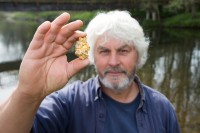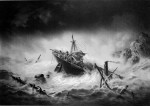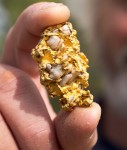 A treasure hunter has found the largest nugget of gold ever discovered in the UK near the shipwreck of the Royal Charter off the coast of Anglesey, northwest Wales. Vincent Thurkettle was shallow diving when he spotted the nugget in a crevice about 40 meters (131 feet) from the wreck and just five meters (16 feet) from the shore. The wreck and its environs are usually covered in six feet of sand, but storms had shifted the sands and exposed the crevice in the sea bed and the chicken egg of gold nesting inside of it. At 97.12 grams (3 oz), the nugget is almost twice the weight of second biggest nugget ever found in Britain, the Carnon Nugget, which weighs 59g and was found in Cornwall in 1808. The third largest at 57.9g is the Rutherford Nugget, found in Scotland in 1869.
A treasure hunter has found the largest nugget of gold ever discovered in the UK near the shipwreck of the Royal Charter off the coast of Anglesey, northwest Wales. Vincent Thurkettle was shallow diving when he spotted the nugget in a crevice about 40 meters (131 feet) from the wreck and just five meters (16 feet) from the shore. The wreck and its environs are usually covered in six feet of sand, but storms had shifted the sands and exposed the crevice in the sea bed and the chicken egg of gold nesting inside of it. At 97.12 grams (3 oz), the nugget is almost twice the weight of second biggest nugget ever found in Britain, the Carnon Nugget, which weighs 59g and was found in Cornwall in 1808. The third largest at 57.9g is the Rutherford Nugget, found in Scotland in 1869.
 Built in 1855, the Royal Charter was an iron-hulled steam clipper with sails and back-up steam engines which could be used when the wind was uncooperative. Its speed and sturdiness made it the ideal ship for the challenging Liverpool-Australia route which crossed almost the entire length of the Atlantic, passing through the Cape of Good Hope, notorious for its brutal storms. The Royal Charter pulled off this crossing in fewer than 60 days, a cakewalk for the time, and thanks to the discovery of gold in Victoria in 1851, there were plenty of passengers most extremely keen to get to the antipodes to try their luck in the Australian Gold Rush. The return voyage was typically replete with prospectors carrying the fruits of their panning and digging labour.
Built in 1855, the Royal Charter was an iron-hulled steam clipper with sails and back-up steam engines which could be used when the wind was uncooperative. Its speed and sturdiness made it the ideal ship for the challenging Liverpool-Australia route which crossed almost the entire length of the Atlantic, passing through the Cape of Good Hope, notorious for its brutal storms. The Royal Charter pulled off this crossing in fewer than 60 days, a cakewalk for the time, and thanks to the discovery of gold in Victoria in 1851, there were plenty of passengers most extremely keen to get to the antipodes to try their luck in the Australian Gold Rush. The return voyage was typically replete with prospectors carrying the fruits of their panning and digging labour.
It was on one of those return trips from Australia to Liverpool that the Royal Charter, laden with a cargo of 79,000 ounces of Australian gold insured for £322,000 (worth an estimated £120 million in today’s money) plus much more carried by miner passengers, encountered a violent storm off the coast of Anglesey near the village of Moelfre. The captain decided to drop anchor in Moelfre Bay, lower the sails and shut down the engines lest the northerly winds drive the ship towards North Wales. This proved a fateful decision as it kept the ship in the middle of the roughest part of the storm. Assaulted by waves 60 feet high and winds of 100 miles per hour, the anchor chain broke and the ship was dashed onto the rocks. In the wee hours of on October 26th, 1859, the Royal Charter broke apart and sank.
 One of the crew managed to get to the shore 50 yards away towing a lifeline, but a total of only 39 people — 21 passengers, 18 crew, all men — were able to use the lifeline to reach the safety of the shore. The exact number of passengers and crew is unknown but is estimated to be around 450. The passenger manifest listed 320, but people who purchased last-minute tickets weren’t listed. In the two weeks between October 25th and November 9th of that year, storms wrecked 325 ships taking 748 people down with them. The dead from the Royal Charter make up more than half of that terrible total.
One of the crew managed to get to the shore 50 yards away towing a lifeline, but a total of only 39 people — 21 passengers, 18 crew, all men — were able to use the lifeline to reach the safety of the shore. The exact number of passengers and crew is unknown but is estimated to be around 450. The passenger manifest listed 320, but people who purchased last-minute tickets weren’t listed. In the two weeks between October 25th and November 9th of that year, storms wrecked 325 ships taking 748 people down with them. The dead from the Royal Charter make up more than half of that terrible total.
The storm, which was so massive around 200 ships sank in it, became known as the “Royal Charter gale.” As a result of the tragedy, the Meteorological Department of the Board of Trade, which was only five years old at the time and only collected meteorological observations, was made to issue official gale warnings via the new telegraph technology to ships in British waters. The first gale warnings were issued in June of 1860.
 The owners of the ship and insurance underwriters set to salvaging what they could of the Royal Charter‘s valuable cargo. When Charles Dickens visited the wreck site on New Year’s Eve, 1859, salvage operations were still ongoing. He described the wreck and the salvage he witnessed in The Uncommercial Traveller.
The owners of the ship and insurance underwriters set to salvaging what they could of the Royal Charter‘s valuable cargo. When Charles Dickens visited the wreck site on New Year’s Eve, 1859, salvage operations were still ongoing. He described the wreck and the salvage he witnessed in The Uncommercial Traveller.
Even as I stood on the beach with the words ‘Here she went down!’ in my ears, a diver in his grotesque dress, dipped heavily over the side of the boat alongside the Lighter, and dropped to the bottom. On the shore by the water’s edge, was a rough tent, made of fragments of wreck, where other divers and workmen sheltered themselves, and where they had kept Christmas-day with rum and roast beef, to the destruction of their frail chimney. Cast up among the stones and boulders of the beach, were great spars of the lost vessel, and masses of iron twisted by the fury of the sea into the strangest forms. The timber was already bleached and iron rusted, and even these objects did no violence to the prevailing air the whole scene wore, of having been exactly the same for years and years. […]
The divers were down then, and busy. They were ‘lifting’ to-day the gold found yesterday—some five-and-twenty thousand pounds. Of three hundred and fifty thousand pounds’ worth of gold, three hundred thousand pounds’ worth, in round numbers, was at that time recovered. The great bulk of the remainder was surely and steadily coming up. Some loss of sovereigns there would be, of course; indeed, at first sovereigns had drifted in with the sand, and been scattered far and wide over the beach, like sea-shells; but most other golden treasure would be found. As it was brought up, it went aboard the Tug-steamer, where good account was taken of it. So tremendous had the force of the sea been when it broke the ship, that it had beaten one great ingot of gold, deep into a strong and heavy piece of her solid iron-work: in which, also, several loose sovereigns that the ingot had swept in before it, had been found, as firmly embedded as though the iron had been liquid when they were forced there. It had been remarked of such bodies come ashore, too, as had been seen by scientific men, that they had been stunned to death, and not suffocated. Observation, both of the internal change that had been wrought in them, and of their external expression, showed death to have been thus merciful and easy.
 Official salvage continued for years, and when the companies finally called it a day with about 80% of the cargo recovered, unofficial treasure hunters persisted. They continue to persist to this day. Vincent Thurkettle is a professional prospector and has been panning/diving for treasure for close to 40 years. He’s been leading teams of friends and relatives to the explore Royal Charter site for years. In 2011 he made the news for finding gold dust, nuggets, coins and 200 artifacts from the wreck. He kept mum on the big nugget, which he discovered in 2012, in order to continue to search the site without interference from the public. Also, he developed something of a Gazza Ladra love for this great find. “I had grown very fond of it,” he said. “Other pieces I’ve found before have been quartz with gold in, but this was a big lump of gold with bits of quartz in.”
Official salvage continued for years, and when the companies finally called it a day with about 80% of the cargo recovered, unofficial treasure hunters persisted. They continue to persist to this day. Vincent Thurkettle is a professional prospector and has been panning/diving for treasure for close to 40 years. He’s been leading teams of friends and relatives to the explore Royal Charter site for years. In 2011 he made the news for finding gold dust, nuggets, coins and 200 artifacts from the wreck. He kept mum on the big nugget, which he discovered in 2012, in order to continue to search the site without interference from the public. Also, he developed something of a Gazza Ladra love for this great find. “I had grown very fond of it,” he said. “Other pieces I’ve found before have been quartz with gold in, but this was a big lump of gold with bits of quartz in.”
 Anything found close to a shipwreck by law has to be reported to the Receiver of Wreck (RoW) which then researches ownership and determines where the salvage should go. It’s not clear when Thurkettle reported it. He kept it for long enough to grow fond of it, so it seems it wasn’t immediately turned over to the Receiver. The RoW has claimed it for the crown now, which means they’ve probably had it for at least a year since the law says they’re supposed to hold on to wreck salvage for a year to give private owners a chance to claim it.
Anything found close to a shipwreck by law has to be reported to the Receiver of Wreck (RoW) which then researches ownership and determines where the salvage should go. It’s not clear when Thurkettle reported it. He kept it for long enough to grow fond of it, so it seems it wasn’t immediately turned over to the Receiver. The RoW has claimed it for the crown now, which means they’ve probably had it for at least a year since the law says they’re supposed to hold on to wreck salvage for a year to give private owners a chance to claim it.
The nugget is currently stashed in a safe place before it finds a new home in a museum. Thurkettle will have to content himself with a salvage award and the same visitation rights the rest of the public will get when the nugget goes on display.